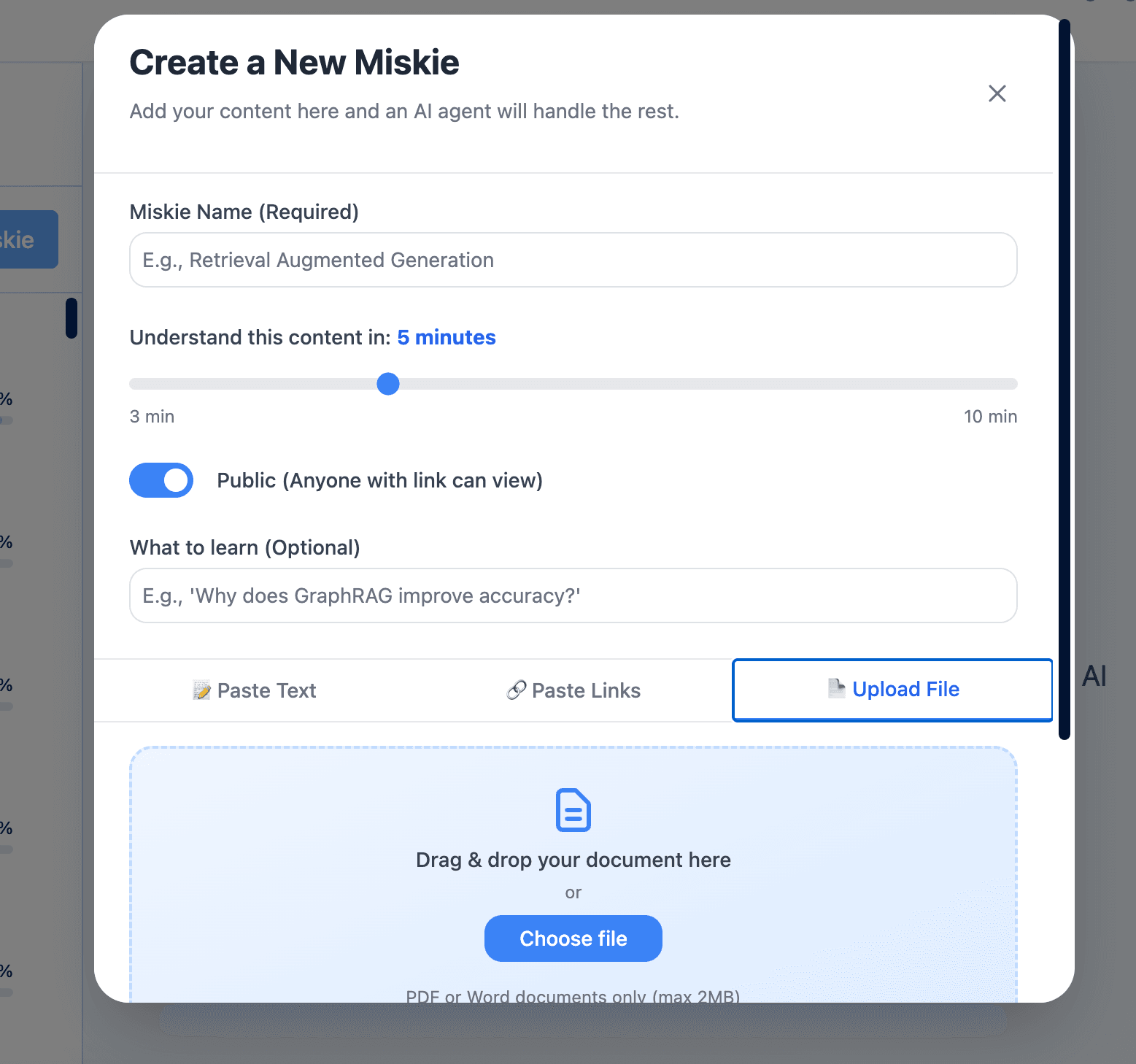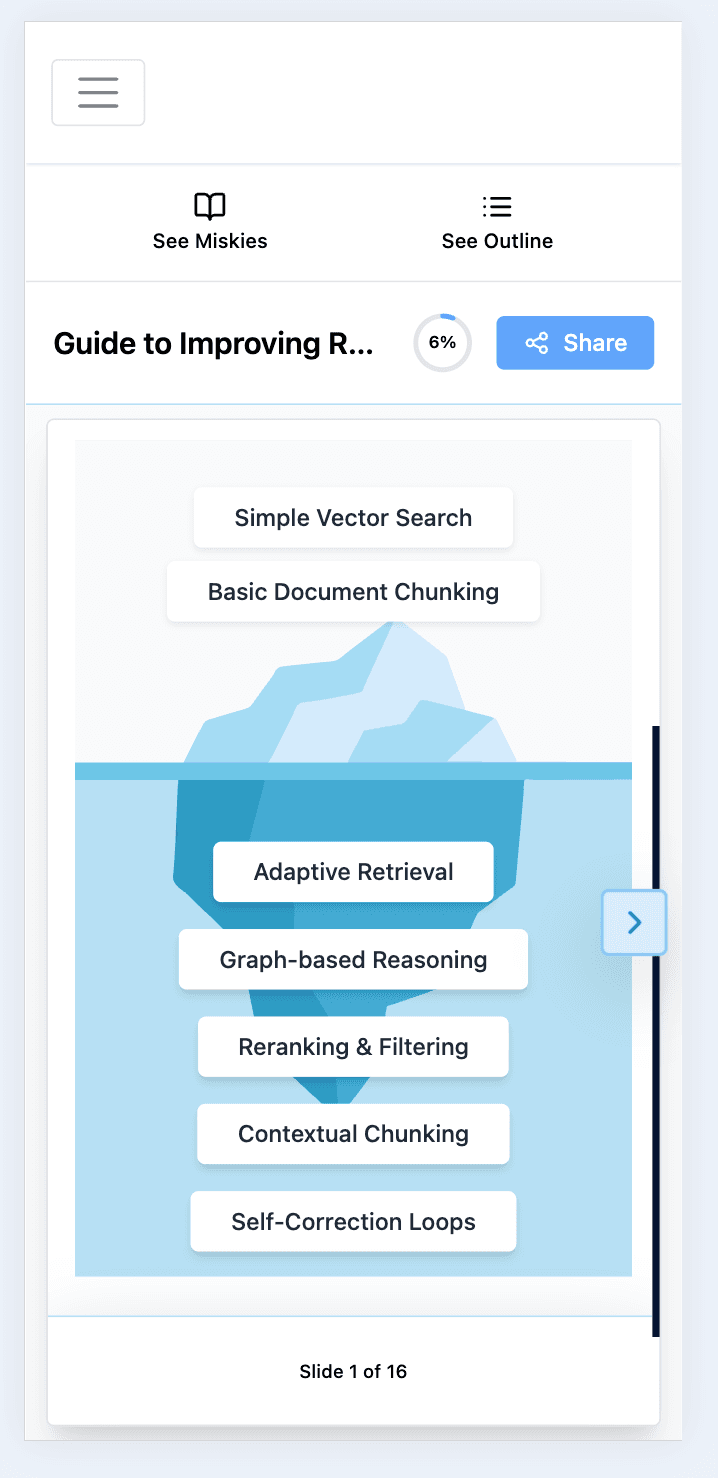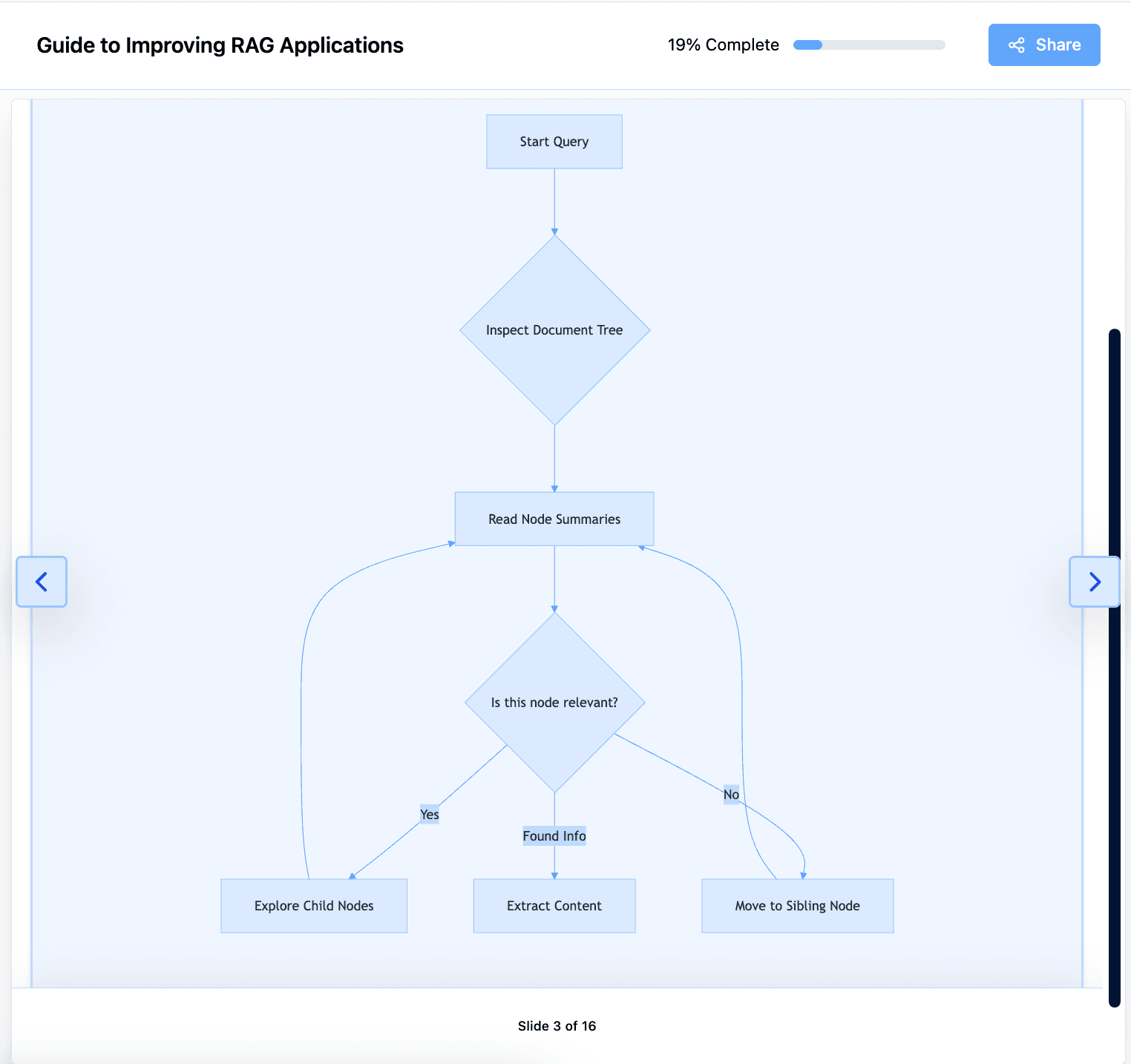How to Study Complex Topics 10x Faster with Visual Learning
Struggling with difficult concepts in advanced physics? Confused by abstract theories in philosophy? Overwhelmed by intricate business frameworks? Complex topics don't have to take forever to master.
Visual learning techniques can help you understand challenging subjects in a fraction of the time—turning hours of confusion into minutes of clarity.
Why Complex Topics Feel So Hard
Traditional study methods fail with complex topics because:
- Too much information at once - Cognitive overload
- Abstract concepts - Hard to visualize mentally
- Interconnected ideas - Can't see relationships
- Dense text - No clear structure
- Passive reading - No engagement with material
- No feedback loop - Don't know if you understand
Result: Spending hours studying without real comprehension.
The Visual Learning Advantage for Complex Topics
Visual learning accelerates understanding by:
- Breaking complexity into chunks - One concept at a time
- Making abstract concrete - Visual representations of ideas
- Showing relationships - How concepts connect
- Providing structure - Clear organization of information
- Enabling active engagement - Interactive exercises
- Testing understanding - Immediate feedback
Research shows: Visual learners process information 60,000x faster than text-only learners.
The 10x Faster Visual Learning Method
Step 1: Identify Your Complex Topic
Choose the challenging subject you need to master:
- Quantum mechanics principles
- Organic chemistry reactions
- Advanced calculus concepts
- Economic theory frameworks
- Philosophical arguments
- Programming paradigms
Step 2: Convert to Visual Format
Go to https://www.miskies.app/miskies and click "Create New Miskie".

Step 3: Define Your Learning Goal
Be specific about what you find complex:
- Topic name: "Quantum Entanglement Explained"
- Learning objective: "Understand how entanglement works and why it's weird"
- Time available: "15 minutes"

Step 4: Input Learning Materials
Add resources about your complex topic:
- Textbook sections explaining the concept
- Online articles or tutorials
- Lecture notes from class
- Research papers (for academic topics)

Step 5: Study Visual Breakdown
In 30 seconds, receive visual explanations:
Hierarchical Diagrams - For understanding levels and structure:
- Pyramid diagrams show concept hierarchies
- Break complex topics into manageable levels
Process Diagrams - For understanding sequences:
- Flowcharts show step-by-step processes
- Sequence diagrams explain chronological events
Relationship Diagrams - For understanding connections:
- Venn diagrams show overlaps and relationships
- Network diagrams show how concepts interact
Comparison Diagrams - For understanding differences:
- Scale diagrams show spectrums and ranges
- Side-by-side comparisons highlight distinctions


Interactive Practice - For testing comprehension:
- Hands-on exercises applying concepts
- Scenario-based problems
- Knowledge check quizzes
Complex Topics Made Simple: Real Examples
Example 1: Organic Chemistry Reactions
Traditional approach:
- Read 50 pages about reaction mechanisms
- Memorize conditions and products
- Struggle to remember steps
Visual learning approach:
- Flowchart showing reaction sequence
- Diagram highlighting electron movement
- Interactive exercise practicing mechanism
Result: 3 hours → 20 minutes to mastery.
Example 2: Macroeconomic Theory
Traditional approach:
- Dense textbook chapters about fiscal policy
- Abstract concepts hard to grasp
- Can't see cause-and-effect
Visual learning approach:
- Flywheel diagram showing economic cycles
- Flowchart of policy impacts
- Scale diagram of inflation effects
Result: 4 hours → 25 minutes to understanding.
Example 3: Advanced Calculus
Traditional approach:
- Pages of mathematical proofs
- Abstract theorems
- Difficult to visualize
Visual learning approach:
- Sequence diagrams breaking down proofs
- Visual representations of limits
- Step-by-step problem walkthroughs
Result: 5 hours → 30 minutes to comprehension.
Visual Learning Strategies for Different Complex Topics
STEM Subjects
Physics & Engineering:
- System diagrams for complex machinery
- Flowcharts for problem-solving approaches
- Sequence diagrams for experimental procedures
Mathematics:
- Step-by-step proof visualizations
- Concept relationship maps
- Visual formula derivations
Computer Science:
- Algorithm flowcharts
- Data structure diagrams
- System architecture visuals
Theoretical Subjects
Philosophy:
- Argument structure diagrams
- Concept relationship maps
- Timeline of philosophical development
Economics:
- Market cycle diagrams
- Supply-demand visualizations
- Policy impact flowcharts
Psychology:
- Theory comparison charts
- Process models (cognition, behavior)
- Experimental design diagrams
Professional Topics
Business Strategy:
- Framework visualizations
- Decision tree diagrams
- Market analysis charts
Legal Studies:
- Case law hierarchies
- Argument structure maps
- Procedure flowcharts
Medical Sciences:
- Physiological process diagrams
- Disease progression flowcharts
- Treatment protocol visuals
The 10x Faster Study Process
Traditional Method (Slow):
- Read dense textbook chapter (2 hours)
- Highlight important parts (30 minutes)
- Make notes (1 hour)
- Try to understand (1 hour)
- Re-read confusing parts (1 hour)
- Still unclear on key concepts
Total: 5.5+ hours, incomplete understanding
Visual Learning Method (Fast):
- Upload chapter to Miskies (1 minute)
- AI generates visual breakdown (30 seconds)
- Review visual diagrams (10 minutes)
- Complete interactive exercises (10 minutes)
- Take knowledge check quiz (5 minutes)
- Master the concepts!
Total: 26.5 minutes, complete understanding
That's over 10x faster!
Why Visual Learning Works for Complex Topics
1. Reduces Cognitive Load
Complex topics overwhelm working memory. Visuals simplify information into digestible chunks.
2. Leverages Visual Processing
The brain processes visual information 60,000x faster than text, perfect for complex material.
3. Shows Hidden Structure
Visual diagrams reveal organizational patterns invisible in text format.
4. Enables Pattern Recognition
Similar complex concepts use similar visual patterns, accelerating future learning.
5. Supports Multiple Learning Passes
Quick visual review enables spaced repetition for long-term retention.
6. Provides Concrete Anchors
Abstract concepts become concrete through visual representation.
Study Tips for Maximum Speed
Before Visual Study:
- Identify specific confusion points - What exactly don't you understand?
- Set clear goals - What do you need to know by when?
- Gather all materials - Textbooks, notes, articles
During Visual Study:
- Focus on one concept at a time - Don't rush through slides
- Redraw key diagrams - Engages muscle memory
- Explain visuals aloud - Tests your understanding
- Complete all exercises - Active practice solidifies learning
After Visual Study:
- Test yourself immediately - Use quizzes to verify understanding
- Teach someone else - Use visuals to explain concepts
- Review after 24 hours - Spaced repetition boosts retention
- Apply to problems - Use new understanding on practice problems
Measuring Your Speed Improvement
Track your progress:
Before visual learning:
- Time to understand new concept: ___ hours
- Retention after one week: ___%
- Exam performance: ___ score
After visual learning:
- Time to understand new concept: ___ minutes
- Retention after one week: ___%
- Exam performance: ___ score
Most students report:
- 5-10x faster comprehension
- 80%+ retention rates
- Significant grade improvements
Advanced Complex Topic Strategies
The Multi-Perspective Approach
For extremely complex topics:
- Create visual breakdown of textbook explanation
- Create visual breakdown of online tutorial
- Create visual breakdown of lecture notes
- Compare all three visual representations
- Synthesize into comprehensive understanding
The Layered Learning Approach
For topics with prerequisites:
- Create visuals for foundational concepts first
- Build second layer of intermediate concepts
- Add top layer of advanced concepts
- Review entire pyramid regularly
The Connection Mapping Approach
For interconnected complex topics:
- Create visual for each major concept
- Identify overlaps and connections
- Build master diagram showing relationships
- Use master map for holistic understanding
The Problem-Solution Approach
For applied complex topics:
- Identify typical problems in the field
- Create visuals showing solution processes
- Practice with multiple problem types
- Build pattern recognition skills
Common Mistakes to Avoid
❌ Trying to understand everything at once ✅ Break into smaller sub-topics and visualize separately
❌ Skipping the interactive exercises ✅ Active practice is essential for complex topics
❌ Not reviewing visual materials multiple times ✅ Spaced repetition required for long-term retention
❌ Only reading the visuals passively ✅ Redraw diagrams, explain aloud, teach others
❌ Giving up after first pass ✅ Complex topics may need 2-3 visual study sessions
Building Complex Topic Mastery
Week 1: Foundation
- Create visuals for basic concepts
- Review daily for 10 minutes
- Complete all exercises
Week 2: Depth
- Add more complex sub-topics
- Connect to foundation concepts
- Practice application problems
Week 3: Integration
- Create comprehensive overview visuals
- Test with advanced problems
- Teach concepts to others
Week 4: Mastery
- Quick refreshers on all visuals
- Tackle most difficult problems
- Ready for exams or applications
Start Learning Complex Topics Faster
Stop spending hours confused by difficult subjects. Transform complex topics into clear, visual understanding in minutes.
Visit Miskies AI and master your first complex topic today.
Free to Start • 30 Second Generation • Works for Any Complex Topic
Keywords: learn complex topics faster, visual learning methods, understand difficult concepts, master complex subjects, accelerated learning, visual study techniques, complex topic comprehension, learn faster with visuals, difficult subject mastery, rapid learning strategies